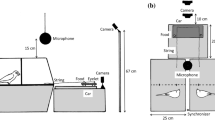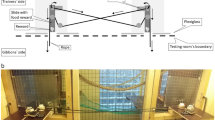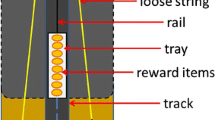Abstract
One of the main characteristics of human societies is the extensive degree of cooperation among individuals. Cooperation is an elaborate phenomenon, also found in non-human primates during laboratory studies and field observations of animal hunting behaviour, among other things. Some authors suggest that the pressures assumed to have favoured the emergence of social intelligence in primates are similar to those that may have permitted the emergence of complex cognitive abilities in some bird species such as corvids and psittacids. In the wild, parrots show cooperative behaviours such as bi-parental care and mobbing. In this study, we tested cooperative problem solving in African grey parrots (Psittacus erithacus). Our birds were tested using several experimental setups to explore the different levels of behavioural organisation between participants, differing in temporal and spatial complexity. In our experiments, African grey parrots were able to act simultaneously but mostly failed during the delay task, maybe because of a lack of inhibitory motor response. Confronted with the possibility to adapt their behaviour to the presence or absence of a partner, they showed that they were able to coordinate their actions. They also collaborated, acting complementarily in order to solve tasks, but they were not able to place themselves in the partner’s role.






Similar content being viewed by others
References
Al Aïn S, Giret N, Grand M, Kreutzer M, Bovet D (2009) The discrimination of discrete and continuous amounts in African grey parrots (Psittacus erithacus). Anim Cogn 12(1):145–154
Bergmüller R, Johnstone RA, Russell AF, Bshary R (2007) Integrating cooperative breeding into theoretical concepts of cooperation. Behav Proc 76(2):61–72
Bergmüller R, Schürch R, Hamilton IM (2010) Evolutionary causes and consequences of consistent individual variation in cooperative behaviour. Phil Trans R Soc B 365:2751–2764
Brosnan SF, Bshary R (2010) Cooperation and deception: from evolution to mechanisms. Phil Trans R Soc B 365:2593–2598
Brosnan SF, de Waal FBM (2002) Variation on tit-for-tat: proximate mechanisms of cooperation and reciprocity. Hum Nat 13:129–152
Brosnan SF, Salwiczek L, Bshary R (2010) The interplay of cognition and cooperation. Phil Trans R Soc B 365:2699–2710
Byrne R, Whiten A (1988) Machiavellian intelligence: social expertise and the evolution of intellect in monkeys, apes, and humans. Oxford University Press, Oxford
Chalmeau R, Visalberghi E, Gallo A (1997) Capuchin monkeys, Cebus apella, fail to understand a cooperative task. Anim Behav 54:1215–1225
Cockburn A (2006) Prevalence of different modes of parental care in birds. Proc R Soc B 273(1592):1375–1383
Cronin K, Kurian A, Snowdon C (2005) Cooperative problem solving in a cooperatively breeding primate (Saguinus oedipus). Anim Behav 69(1):133–142
Dawkins MS (2002) What are birds looking at? Head movements and eye use in chickens. Anim Behav 63:991–998
De Waal FBM, Suchak M (2010) Prosocial primates: selfish and unselfish motivations. Phil Trans R Soc B 365:2711–2722
Drea CM, Carter AN (2009) Cooperative problem solving in a social carnivore. Anim Behav 78(4):967–977
Dunbar RIM (1998) The social brain hypothesis. Evolut Anthropol 6:178–189
Dunbar RIM, Shultz S (2007) Evolution in the social brain. Science 317(5843):1344–1347
Emery NJ, Seed AM, von Bayern AM, Clayton NS (2007) Cognitive adaptations of social bonding in birds. Phil Trans R Soc B 362:489–505
Giret N, Miklósi Á, Kreutzer M, Bovet D (2009a) Use of experimenter-given cues by African gray parrots (Psittacus erithacus). Anim Cogn 12(1):113–121
Giret N, Monbureau M, Kreutzer M, Bovet D (2009b) Conspecific discrimination in an object-choice task in African grey parrots (Psittacus erithacus). Behav Process 82:75–77
Hare B, Melis AP, Woods V, Hastings S, Wrangham RW (2007) Tolerance allows bonobos to outperform chimpanzees on a cooperative task. Curr Biol 17:619–623
Harrison GJ (1994) Perspective on parrot behaviour. In: Ritchie BW, Harrison GJ, Harrison LR (eds) Avian medicine: principles and application. Wingers Publishing, Lake Worth, Fl, pp 96–108
Hirata S, Fuwa K (2007) Chimpanzees (Pan troglodytes) learn to act with other individuals in a cooperative task. Primates 48:13–21
Huber L, Gajdon GK, Federspiel IG, Werdenich D (2008) Cooperation in keas: social and cognitive factors. In: Itakura S, Fujita K (eds) Origins of the social mind: evolutionary and developmental views. Springer, Tokyo, pp 99–119
Humphrey NK (1976) The social function of intellect. In: Bateson PPG, Hinde RA (eds) Growing points in ethology. Cambridge University Press, Cambridge, pp 303–317
Iwaniuk AN, Dean KM, Nelson JE (2005) Interspecific allometry of the brain and brain regions in parrots (psittaciformes): comparisons with other birds and primates. Brain Behav Evol 65:40–59
Joly A (1966) Lemur social behaviour and primate intelligence. Science 153:501–506
Jones P, Tye A (2006) The birds of são tomé and príncipe, with annobón, islands of the gulf of guinea: an annotated checklist. British Ornithologists’ Union, Oxford
May DL (2004) The vocal repertoire of grey parrots (Psittacus erithacus) living in the Congo basin. Dissertation
Melis AP, Semmann D (2010) How is human cooperation different? Phil Trans R Soc B 365:2663–2674
Melis AP, Hare B, Tomasello M (2006a) Chimpanzees recruit the best collaborators. Science 311:1297–1300
Melis AP, Hare B, Tomasello M (2006b) Engineering cooperation in chimpanzees: tolerance constraints on cooperation. Anim Behav 72(2):275–286
Melis AP, Hare B, Tomasello M (2009) Chimpanzees coordinate in a negotiation game. Evol Hum Behav 30(6):381–392
Mendres KA, de Waal FBM (2000) Capuchins do cooperate: the advantage of an intuitive task. Anim Behav 60:523–529
Möslinger H, kotrschal K, Huber L, Range F, Virányi Z (2009) Cooperative string-pulling in wolves. J Vet Behav Clin Appl Res 4(2):99
Noë R (2006) Cooperation experiments: coordination through communication versus acting apart together. Anim Behav 71(1):1–18
Pepperberg IM (2006) Cognitive and communicative abilities of grey parrots. Appl Anim Behav Sci 100(1–2):77–86
Péron F, Rat-Fischer L, Nagle L, Bovet D (Submitted) Social preferences and negociations during a cooperative task in African grey parrots (Psittacus erithacus)
Scheid C, Noë R (2010) The performance of rooks in a cooperative task depends on their temperament. Anim Cogn 13(3):545–553
Seed AM, Clayton NS, Emery NJ (2008) Cooperative problem solving in rooks (Corvus frugilegus). Proc R Soc B 275:1421–1429
Shettleworth SJ (2009) The evolution of comparative cognition: is the snark still a boojum? Behav Process 80:210–217
Shettleworth SJ (2010) Cognition, evolution, and behaviour, 2nd edn. Oxford University Press, Oxford, UK
Shultz S, Dunbar RIM (2007) The evolution of the social brain: anthropoid primates contrast with other vertebrates. Proc R Soc B 274(1624):2429–2436
Shultz S, Dunbar RIM (2010) Social bonds in birds are associated with brain size and contingent on the correlated evolution of life-history and increased parental investment. Biol J Linn Soc 100:111–123
Silk JB (2002) Using the ‘F’—word in primatology. Behav 139:421–446
Skeate ST (1984) Courtship and reproductive behaviour of captive white-fronted amazon parrots Amazona albifrons. Bird Behav 5:103–109
Spitzhorn H (2009) Flexible cooperation in green-winged macaws (Ara chloroptera) Diploma thesis
Tebbich S, Taborsky M, Winkler H (1996) Social manipulation causes cooperation in keas. Anim Behav 52:1–10
Vick S-J, Bovet D, Anderson J (2009) How do African grey parrots (Psittacus erithacus) perform on a delay of gratification task? Anim Cogn 13(2):351–358
Visalberghi E, Quarantotti B, Tranchida F (2000) Solving a cooperation task without taking into account the partner’s behavior: the case of capuchin monkeys (Cebus apella). J Comp Psychol 114(3):297–301
Werdenich D, Huber H (2002) Social factors determine cooperation in marmosets. Anim Behav 64:771–781
Acknowledgments
We wish to thank Hélène Normand for her help in conducting the experiments. We also thank Philippe Groué, Colette Désaleux, Nicolas Giret, Alexandre Lerch and Marie Monbureau for taking care of the parrots. Lauriane Rat-Fischer drew the illustrations. We thank the anonymous reviewers and Ronald Noë for constructive comments on an earlier version. This experiment was setup within the framework of the ‘Integrating Cooperation Research Across Europe’ project. The experiments comply with the French laws concerning animal care (agreement n° 92–380).
Author information
Authors and Affiliations
Corresponding author
Electronic supplementary material
On the video we can see Zoé waiting for his partner. After ten seconds Léo was placed on the table and went and perch. Thus Zoé pulled the string and both birds eat the reward.
Supplementary material 1 (WMV 9607 kb)
Rights and permissions
About this article
Cite this article
Péron, F., Rat-Fischer, L., Lalot, M. et al. Cooperative problem solving in African grey parrots (Psittacus erithacus). Anim Cogn 14, 545–553 (2011). https://doi.org/10.1007/s10071-011-0389-2
Received:
Revised:
Accepted:
Published:
Issue Date:
DOI: https://doi.org/10.1007/s10071-011-0389-2




